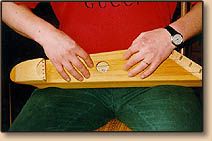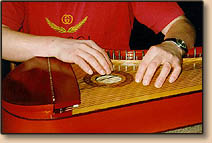When playing the 5-stringed kantele, each string almost always has its own finger. With the box kantele one hand plays the melody and the other accompanies. The music and style of playing on the hollowed kantele tended to favour variation and improvisation. The kantele was used to accompany both singing and dancing.
In Finland we have numerious ways of playing the kantele. It was usually plucked, but in Ostrobothnia (in middle Western Finland, where I live) it was also the custom to stop some of the strings with one hand while allowing the others to sound. A number of surprisingly different early techniques for playing the folk box kantele emerged in various parts of Finland. Many of the regions also developed a kantele model of their own.
It has become common to speak of Perho River Valley style (familiar to me), and North Ostrobothnian style, or stopping style. Players in the Perho River Valley still hold the kantele in the ancient manner, with the short strings nearest to them. In North Ostrobothnia - as indeed all later players of art music on the kantele- hold their instruments the other way round, with the bass strings nearest them. In the latter region the players generally use 7-8 fingers, in the former only 5-6. In the stopping technique the fingers of the left hand stop certain strings while the melody is strummed in the right hand with the index finger, a plectrum, allowing the bass strings to resound at suitable moments. Concertos have been produced for mechanism kantele and it can be heard in all kinds of music from jazz or rock to art music, but mostly in its orginal folk music form.
Studying the kantele
Nowadays kantele-playing can be studied at the Sibelius Academy, the university of music and in many conservatories and schools. In their "kantele for schools" project Folk Music Institute set out to make the old, hollowed-out kantele an instrument that was not only familiar but also actually played. Today there are thousands upon thousands people in Finland with a basic grounding in playing the 5-stringed kantele. The "kantele for schools" project has had many fruitful spin-offs, the most notable of which is probably the gratifying rise in kantele building. There is an active interest in kantele research and devolopment and all the main kantele models are now readily available.
People who have contributed to the development of the Finnish kantele:
Kreeta Haapasalo (1815-1893). The most famous kantele player in the Finnish kantele tradition, lived in the Perho River Valley, a peasant woman who gained a legendary reputation and supported her large family solely by playing the kantele.
Akilles Ockenström (1867-1897). The first kantele player who began giving concerts.
Elias Lönnrot (1802-1884). Compiler of the Kalevala, the Finnish national epic. This epic gave birth to the kantele as one of the Finnish national symbols.
Erkki Ala-Könni (1911-1991). Professor, one of our most illustrious Finnish folk music scholars and collectors.

Playing hollowed 5-string kantele
 Playing boxed kantele
Playing boxed kantele